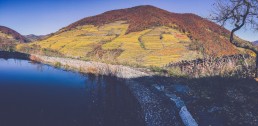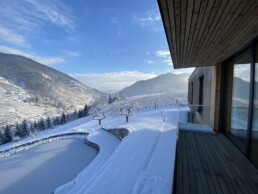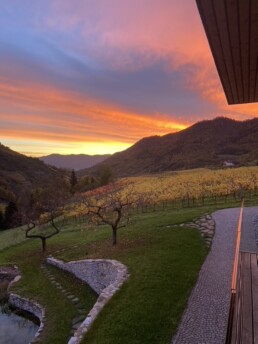The winery
since 2008
The Wachau is characterized more than almost any other wine-growing region by its terraced vineyards on steep slopes with their ancient dry stone walls. These are not only responsible for the visual charm for which the Wachau is so famous. They are responsible for the globally unique character that makes the wines of the Wachau so special.
The manual cultivation of the terraces is extraordinarily time-consuming and requires around five times as much work as vineyards that can be driven on. Many of the old terraces are therefore threatened with abandonment, which would change the protected landscape of the Wachau in the medium term.
Right from the start, I set myself the goal of acquiring exposed terraces with mainly old vines, recultivating them and saving them from clearing. Although this can only be done by hand - without machines - I am convinced that the quality of the wines is so unique, full of character and spectacular that it is worth the effort. The grape production in all the vineyards has been subject to an organic control contract with "Lacon" since August 2008.
The majority of the vines are between 30 and 75 years old. The drinkability and storability of the wines are at the forefront of all work decisions. The processing of healthy grapes without botrytis fungus is the top priority. This results in fine, highly elegant wines with delicate minerality and plenty of tension.
The vineyards
Mostly grown on primary rock, the Grüner Veltliners from the warmest, easternmost part of the Wachau show the many small differences in soil, expanse and altitude every year. The potential top qualities of the vintages promise a classic, authentic "Wachau", each representing the typical vintage characteristics of the region.
On the terraced slopes of the "Hochrain" in Wösendorf my Grüner Veltliner stands on deep loess. The wines here develop nutty and spicy with yellow-fruity aromas. Compared to the Veltliners from the primary rock, the "Hochrain" is a precise example of how much the soil influences the character of the wine.
Situated northwest above Weissenkirchen, the vineyard in this location is planted with the oldest of all my vines (over 70 years old). They produce small grapes with small berries and a naturally low yield. Instead of the peppery spiciness typical of Grüner Veltliner, the berries, like the wine, have a yellow-fruity taste of melon and raisins.
Although the "Bruck" site is considered the best and warmest in Viessling, it is nevertheless one of the coolest, because it is also the highest in the Wachau. Viessling can be seen as a counterpoint to the much warmer terroir of the east of the Wachau. My Rieslings here develop a unique fruitiness with spicy notes and a delicate minerality.
The vineyard is cultivated entirely by hand without a tractor.
Brandstatt is my recultivation project in the Spitzer Graben, the coolest area of the Wachau, at about 450 m above sea level. The originally neglected mica slate vineyard was gradually replanted with Riesling after the walls were repaired. My aim is to press an uncompromising wine on this original terraced vineyard, in which the terroir and an old winemaking tradition are more important than the grape variety. This may involve maceration as well as long ageing in local acacia barrels.
The Buschenberg site lies to the east of the Klaus vineyard and is relatively unknown, as many winegrowers cultivate small plots and hardly any single-vineyard wines have been bottled to date. Large primary rock Riesling soils with low growth potential produce reductive, mineral Riesling with a high ageing potential.
The vines were planted in 1979 and are not suitable for tractors - purely manual work in the vineyard.



























